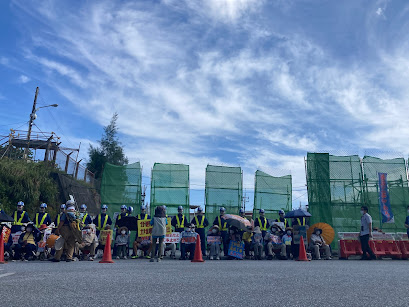A Question that the Ministry of Defense could not Answer
Meetings with Defense and Environment Ministries
On April 14, the Save the Dugong Campaign Center (SDCC) met with officials from the Ministry of Defense and the Ministry of the Environment in the Members’ Office Building of the House of Councilors in Tokyo. I, Hideki Yoshikawa, participated in the meetings as the International Director of SDCC.  |
| Meeting with Defense Ministry Officials Image Source: SDCC |
The office of Councilor Yoichi Iha sponsored the meetings, and Councilor Iha and Councilor Tetsumi Takara delivered speeches before the meetings. Councilor Iha’s sponsorship of the meetings provided legitimacy and demanded answers from the officials to our questions.
Of course, the officials often tried to derail our questions at both meetings, using their usual rhetoric and providing vague answers. “We could not answer these individual and specific questions.” “We are now considering whether we should consider these issues.” Still, we got some interesting responses which should be further interrogated. (See the SDCC blog reports on the meetings here).
Defense Ministry
The officials of the Defense Ministry could not answer whether the U.S. government has recognized (or approved) the Ministry's seafloor reinforcement work as feasible. They repeated that the U.S. government has acknowledged (or received) the Ministry’s reinforcement work study while insisting that the Henoko is the only plan agreed upon by both U.S. and Japanese governments.
Recognizing or approving the Ministry's study as feasible and adhering to the Henoko plan are entirely different concepts. The former involves rigorous scientific analysis and evaluation (feasibility study), and the latter is a policy (which appears to be becoming more like a wish). This distinction is crucial.
No scientific reviews conducted by the U.S. government of the Ministry’s seafloor reinforcement work are publicly available (Probably such studies exist, but they are not made public). From my experience with the dugong lawsuit in the U.S, I believe no level-headed U.S. scientists would risk their reputation and career by going along with the Japanese government’s study.
The Henoko Plan in Question
The Henoko Plan is not a life-or-death project for the U.S. government as a whole, except probably for those in the government and think tanks who have worked with the Japanese government over this controversial plan. Even with the feasibility of the plan now in question, the U.S. government can still continue to stand by and watch how the Japanese government deals with the project, probably counting the accumulating diplomatic debts the Japanese government owes over the plan.
Meanwhile, the Japanese government appears to have struggle to figure out what to do next while needlessly destroying the precious environment of Henoko-OUra Bay. Both governments know that neither their joint statements nor the Japanese court rulings could solidify the mayonnaise-like soft seafloor at the construction site.
Next Step
As a next step, members of civil society aim to obtain the U.S. government’s scientific reviews of the Japanese government’s study of the seafloor reinforcement work.


